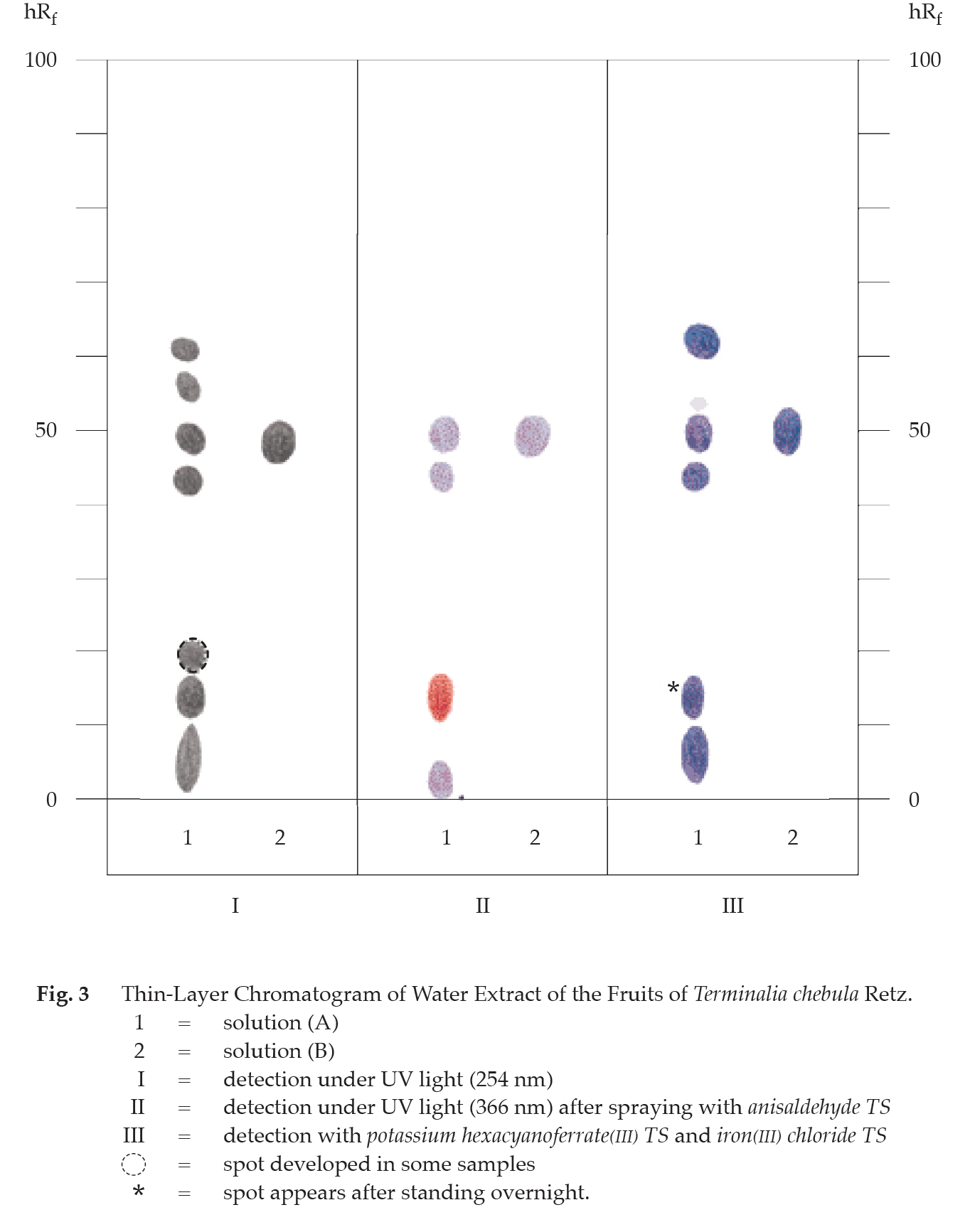ตำรามาตรฐานยาสมุนไพรไทย
Thai Herbal Pharmacopoeia
สำนักยาและวัตถุเสพติด กรมวิทยาศาสตร์การแพทย์ กระทรวงสาธารณสุข
Bureau of Drug and Narcotic, Department of Medical Sciences, Ministry of Public Health(Tinospora crispa (L.) Hook.f. & Thomson)
(Nelumbo nucifera Gaertn.)
(Centella asiatica (L.) Urb.)
(Centella Dry Extract)
(Centella Cream)
(Mesua ferrea L.)
(Piper sarmentosum Roxb.)
(Piper sarmentosum Roxb.)
(Pterocarpus santalinus L. f.)
(Santalum album L.)
(Senna tora (L.) Roxb.)
(Senna alata (L.) Roxb.)
(Senna Alata Tea)
(Piper retrofractum Vahl)
(Myristica fragrans Houtt)
(Andrographis paniculata (Burm. f.) Nees)
(Andrographis Capsules)
(Allium ascalonicum L.)
(Ocimum tenuiflorum L.)
(Curcuma longa L.)
(Turmeric Capsules)
(Turmeric Dry Extract)
(Turmeric Dry Extract Capsules)
(Arcangelisia flava (L.) Merr.)
(Curcuma sp.)
Harrisonia perforata (Blanco) Merr.
(Aristolochia pierrei Lecomte)
(Zingiber officinale Roscoe)
(Ginger Capsules)
(Ginger Tea)
(Cassia fistula L.)
(Nardostachys jatamansi (D. Don) DC.)
(Angelica sinensis (Oliv.) Diels)
Artemisia annua L.
(Ligusticum sinense Oliv. cv. Chuanxiong)
(Neopicrorhiza scrophulariiflora Pennell)
(Atractylodes lancea (Thunb.) DC.)
(Aucklandia lappa Decne)
(Terminalia chebula Retz.)
(Angelica dahurica (Hoffm.) Benth. & Hook. f. ex Franch. & Sav. var. dahurica)
(Kaempferia parviflora Wall. ex Baker)
(Hibiscus sabdariffa L.)
(Roselle Tea)
(Allium sativum L.)
(Zingiber zerumbet (L.) Sm.)
(Wurfbainia testacea (Ridl.) Škorničk.& A. D. Poulsen)
(Cannabis sativa L.)
(Myristica fragrans Houtt)
(Dracaena cochinchinensis (Lour.) S. C. Chen)
(Ficus racemosa L.)
(Hyptis suaveolens (L.) Poit.)
Clerodendrum indicum (L.) Kuntze
(Phyllanthus emblica L.)
(Citrus hystrix DC.)
(Citrus hystrix DC.)
(Areca catechu L.)
(Momordica charantia L.)
Moringa oleifera Lam.
(Aegle marmelos (L.) Corrêa)
(Solanum trilobatum L.)
(Morus alba L.)
Gynostemma pentaphyllum(Thunb.)
Makino
(Clinacanthus nutans (Burm. f.) Lindau)
(Cissus quadrangularis L.)
(Mimusops elengi L.)
(Zingiber montanum (J. König) Link. ex A. Dietr.)
(Piper betle L.)
(Capsicum annuum L.)
(Capsicum Oleoresin)
(Capsicum Gel)
(Piper nigrum L.)
(Piper nigrum L.)
(Eurycoma longifolia Jack)
(Thunbergia laurifolia Lindl.)
(Piper wallichii (Miq.) Hand.-Mazz.)
Senna garrettiana (Craib) H. S. Irwin & Barneby
(Terminalia bellirica (Gaertn.) Roxb.)
(Terminalia chebula Retz.)
(Caesalpinia bonduc (L.) H. Roxb.)
(Tarlmounia elliptica (DC.) H. Rob., S. C. Keeley, Skvaria & R. Chan)
(Hog Creeper Vine Dry Extract Capsiles)
(Hog Creeper Vine Dry Extract)
(Brachypterum scandens (Roxb.) Miq.)
(Lepidium sativum L.)
(Nigella sativa L.)
(Cuminum cyminum L.)
(Foeniculum vulgare Mill.)
(Plantago ovata Forssk.)
(Pimpinella anisum L.)
(Carum carvi L.)
(Anethum graveolens L.)
(Trachyspermum ammi (L.) Sprague)
Albizia procera (Roxb.) Benth.
(Acorus calamus L.)
(Tiliacora triandra (Colebr.) Diels)
Cyanthillium cinereum (L.) H. Rob.
(Orthosiphon aristatus (Blume) Miq.)
Murdannia loriformis (Hassk.) R. S. Rao & Kammathy
(Capparis micracantha DC.)
(Chrysopogon zizanioides (L.) Roberty)
(Cyperus rotundus L.)
(Cannabis sativa L.)
(Syzygium aromaticum (L.) Merr. & L. M. Perry)
(Boesenbergia rotunda (L.) Mansf.)
(Acanthus ebracteatus Vahl)
(Acanthus ilicifolius L.)
(Kaempferia galanga L.)
(Curcuma comosa Roxb.)
Betula alnoides Buch.-Ham. ex D. Don
Cannabis sativa L.
Carthamus tinctorius L
Mitragyna speciosa (Korth.) Havil
Mallotus repandus (Rottler) Müll. Arg
Azadirachta indica A. Juss. var. siamensis Valeton
Azadirachta indica A. Juss. var. siamensis Valeton
Punica granatum L.
Rhinacanthus nasutus (L.) Kurz
Baliospermum solanifolium (Burm.) Suresh
Curcuma aeruginosa Roxb
Boesenbergia kingii Mood & L. M. Prince
Senegalia rugata (Lam.) Britton & Rose
Acacia concinna (Willd.) DC.
Senegalia rugata (Lam.) Britton & Rose
Acacia concinna (Willd.) DC.
Senna alexandriana Mill. var. alexandriana
Cassia acutifolia Delile, Cassia angustifolia Vahl
Butea superba Roxb. ex Willd.
[Plaso superba (Roxb. ex Willd.) Kuntze, Rudolphia superba (Roxb. ex Willd.) Poir.
Pueraria candollei Graham
ex Benth. var. mirifica (Airy Shaw & Suvat.) Niyomdham
Streblus asper Lour.
Suregada multiflora (A. Juss.) Baill. (Gelonium
multiflorum A. Juss.
Chebulic Myrobalan is the dried mature or nearly mature fruit of Terminalia chebula Retz. (Family Combretaceae), Herbarium Specimen Number: DMSC 899.
Constituents Chebulic Myrobalan contains tannins which are chebulinic acid, chebulic acid, tannic acid, gallic acid, etc. It also contains β-sitosterol, saponins, and fixed oil.
Description of the plant (Figs. 1a, 1b) Medium-sized or large tree up to 30 m tall, up to 1.3 m in girth; bark rough, scaly; shoots and young leaves usually rus ty villous. Leaves simple, opposite, coriaceous, broadly ovate to ovate-elliptic, 8 to 15 cm long, 6 to 10 cm wide, glabrescent, nerves obscure above, slightly raised and usually brownish pubescent beneath, apex acute or abruptly acuminate, base cuneate, slightly cordate or rounded; petiole 1 to 3 cm long, glabrous or sparsely pubescent with a pair of nodular glands near leaf-base. Inflorescence axillary or terminal panicle, usually with 3 to 6 spikes; spike 3 to 6 cm long; rachis pubescent; flower 2 mm long, 3 to 4 mm in diameter; bract nearly glabrous, 1.5 to 2 mm long; calyx outside glabrous, inside densely villous, calyx-segment triangular; stamen 3 to 4 mm long; ovary glabrous, ovoid, about 1 mm long; style glabrous, 2.5 to 3 mm long, disc lobed, densely villous. Fruit drupe, glabrous, subglobose to ellipsoid, 2.5 to 5 cm long, 1.5 to 2.5 cm wide, usually smooth or frequently 5-angulate ridged, wrinkled, turning blackish when dry. Seed 1, rough, ellipsoid, 1.5 to 2 cm long, 0.5 to 0.7 cm wide, without ridges.
Description Odour, indistinct; taste, sour, slightly bitter and astringent.
Macroscopical (Fig. 1a) Long ovoid to ovoid, 2.5 to 5 cm long, 1.5 to 2.5 cm wide; externally yellowish brown to dark brown, slightly gross, 5 to 6 longitudinal ridges, irregularly arranged wrinkles in the inter ridge. The base marked by a circular scar, about 2 mm in diameter. Seed 1, about 6 mm in diameter in the central part of hard endocarp.
Microscopical (Figs. 2a, 2b, 2c) Transverse section of the fruit shows epicarp composed of a layer of epidermal cells, the outer tangential wall and upper portion of the radial walls, thick. Mesocarp, 2 to 3 layers of collenchyma followed by a broad zone of parenchyma in which fibres and sclereids, in group, and vascular bundles, scattered; fibres, simple-pitted walls, porous parenchyma; sclereids, various shapes and sizes, mostly elongated; tannins and aggregate crystals of calcium oxalate in parenchyma. Endocarp consists of thick-walled sclereids of various shapes and sizes, mostly elongated. Fibres, sclereids and vessels, lignified. Testa, a layer of large cubical cells, followed by a zone of reticulate parenchyma and vessels; tegmen consists of collapse parenchyma. Cotyledon folded and containing aleurone grains, oil globules and some rosette aggregate crystals.
Chebulic Myrobalan in powder possesses the diagnostic microscopical characters of the unground drug.
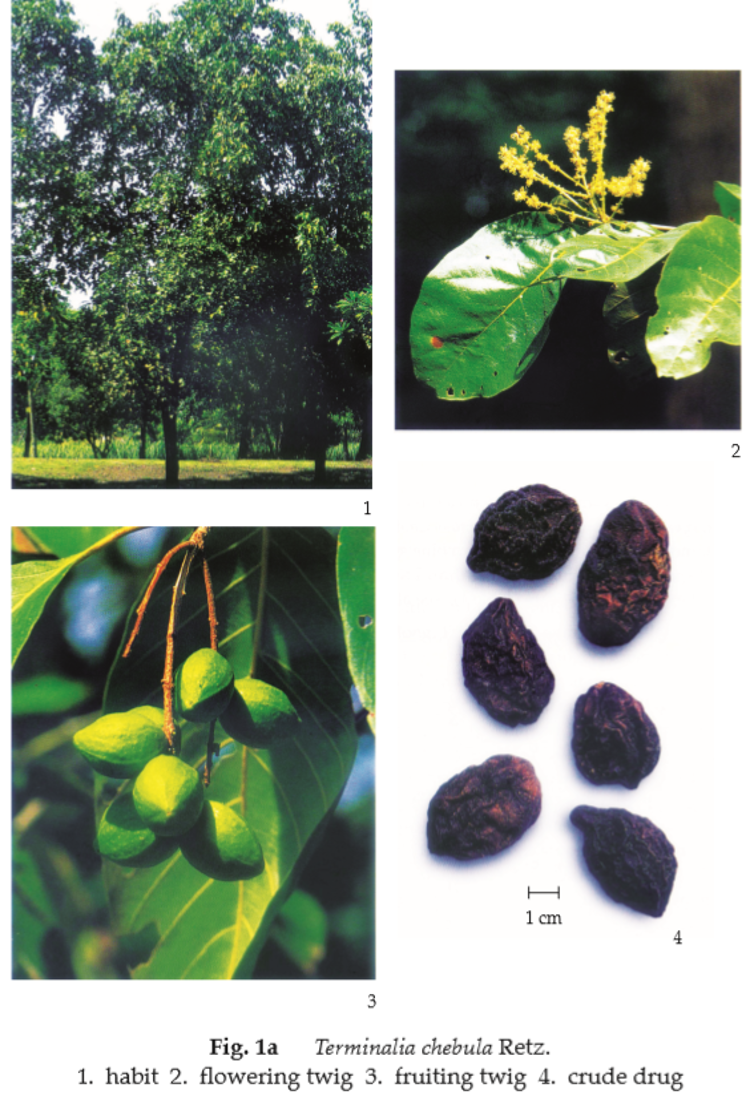
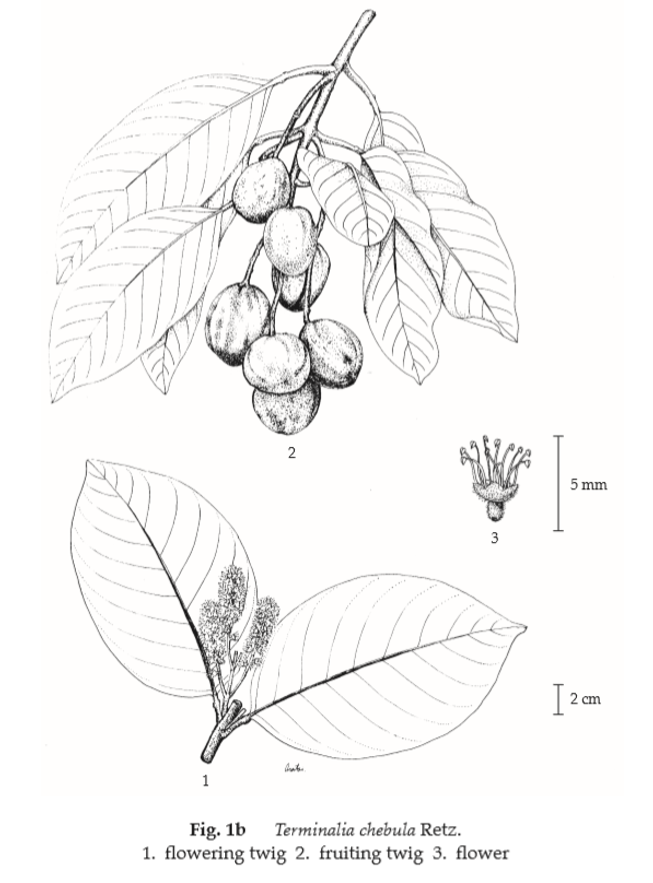
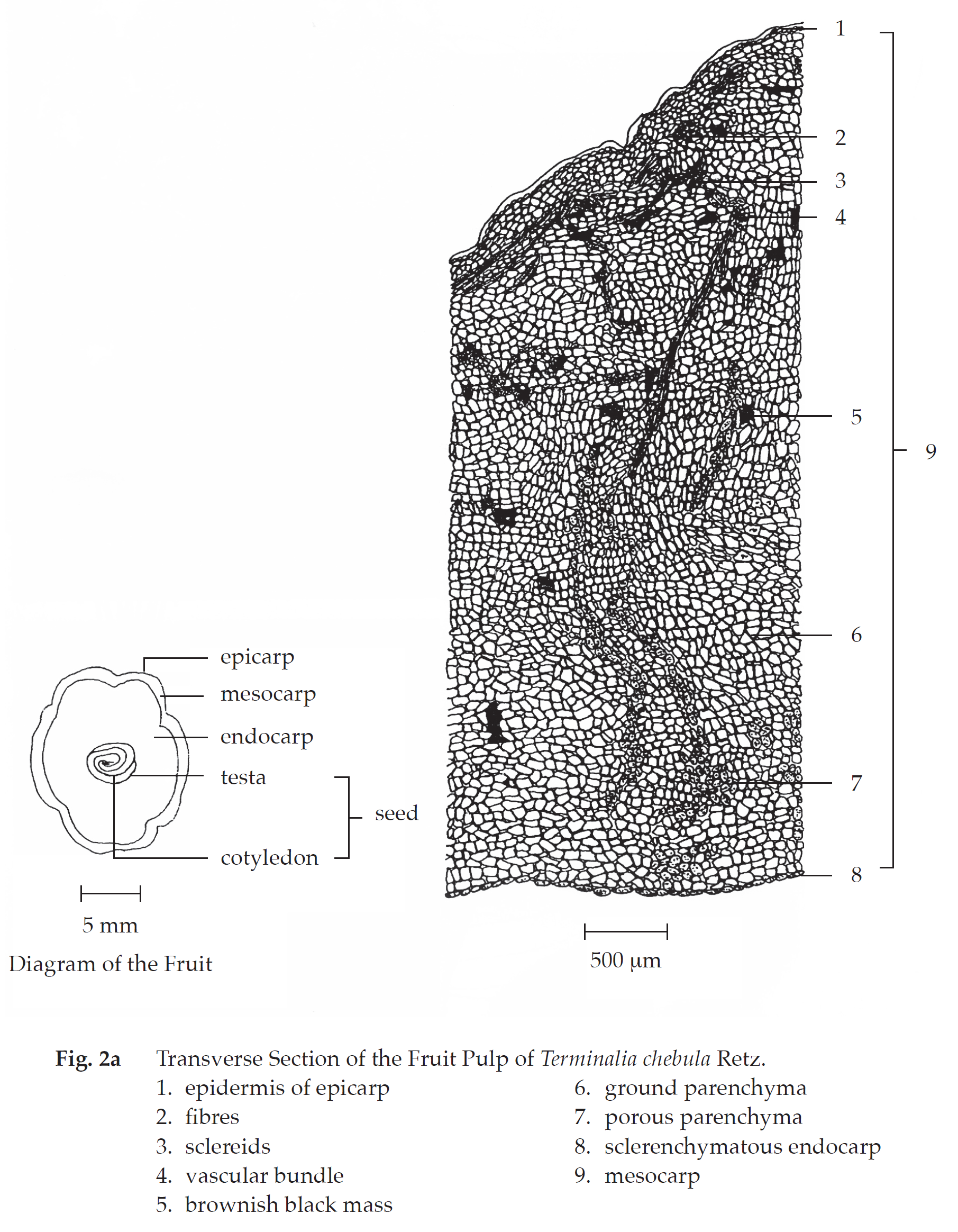
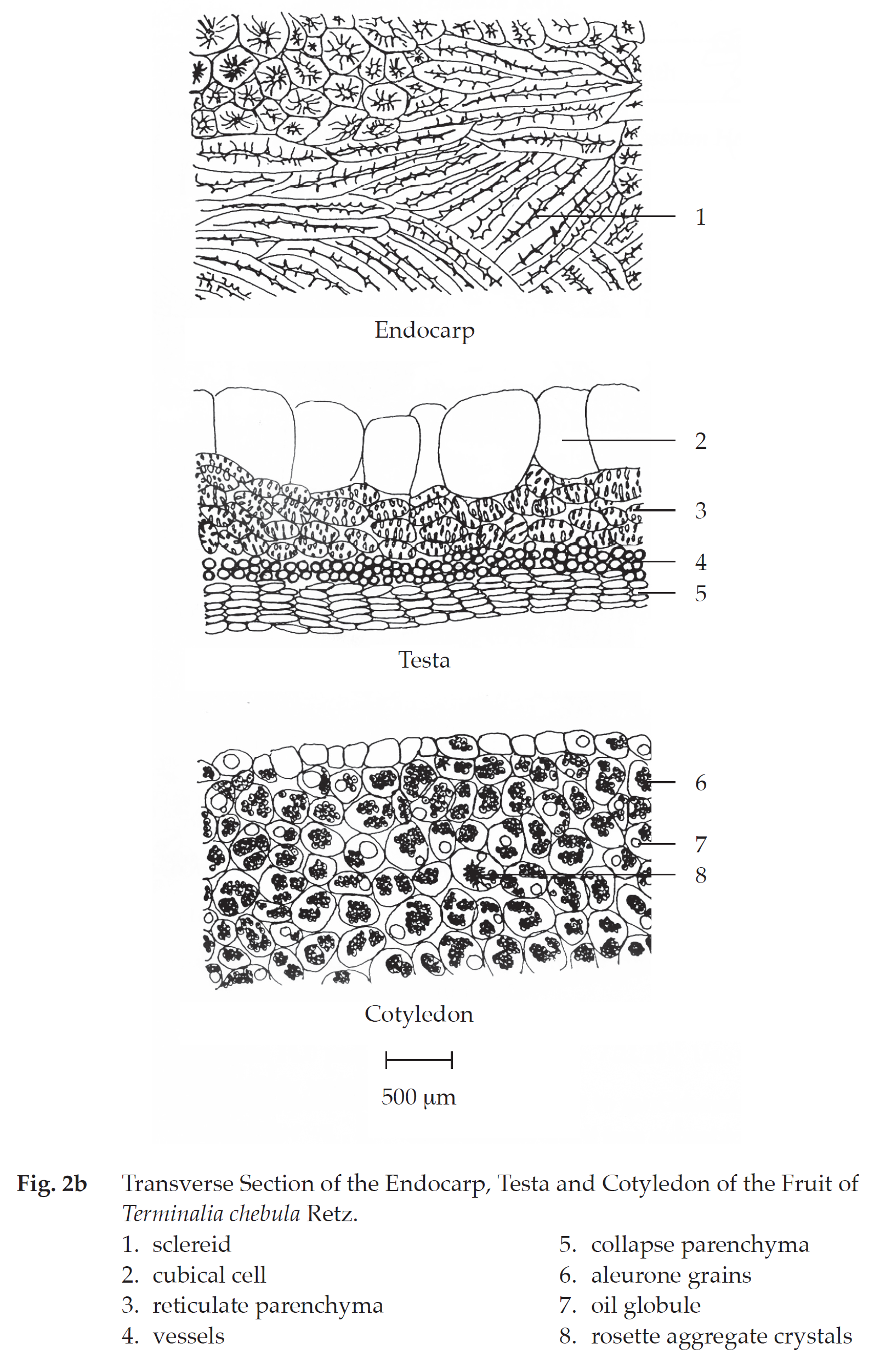
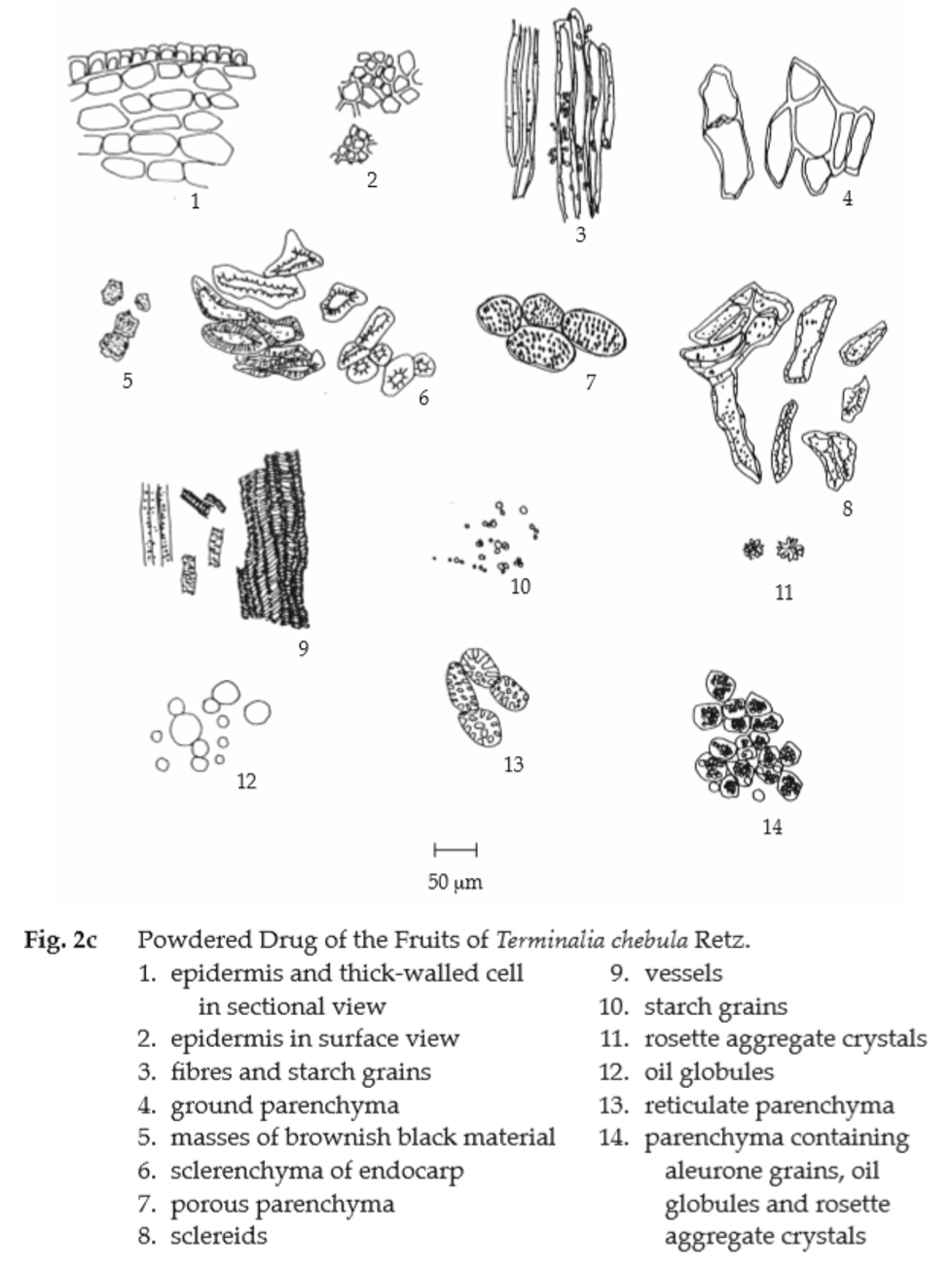
Packaging and storage Chebulic Myrobalan shall be kept in well-closed containers, protected from light, and stored in a dry place.
Identification
A. Reflux 500 mg of the sample, in powder, with 15 mL of chloroform for 15 minutes, filter, and evaporate the filtrate to dryness. Dissolve the residue in 2 mL of acetic anhydride, and then slowly add 1 mL of sulfuric acid to form two layers: a brownish red ring with green upper layer forms.
B. Complies with the tests for Identification B and C described under Belleric Myrobalan.
C. Reflux 200 mg of the sample, in powder, with 10 mL of water for 5 minutes and filter. Transfer 1 mL of the filtrate to a test-tube and shake for a few minutes: a persisting foam is produced for over 30 minutes.
D. Complies with the test for Identification E described under Belleric Myrobalan. After removal of the plate, allow it to dry in air and examine under ultraviolet light (254 nm), marking the quenching spots. The chromatogram obtained from solution (A) shows a quenching spot (hRf value 47 to 50) corresponding to the gallic acid spot from solution (B), and several spots of higher and lower hRf value. Spray the plate with anisaldehyde TS, heat at 105° for 5 minutes, and examine under ultraviolet light (366 nm); the spot due to gallic acid is purple and other two purple and one red fluorescent spots are observed (Table 1); see also Fig. 3.
Repeat the same procedure on another plate but spray with excess amount of potassium hexacyanoferrate(III) TS and then iron(III) chloride TS. Observe immediately, the chromatogram obtained from solution (A) shows a blue spot (hRf value 47 to 50) corresponding to the gallic acid spot from solution (B), other three blue and one white spots. After standing overnight, another blue spot appears (Table 1); see also Fig. 3.
Table 1 hRf Values of Components in Water Extract of the Fruits of Terminalia chebula Retz.
| Spot | hRf Value | Detection | ||
| UV 254 | Anisaldehyde TS and UV 366 |
Potassium Hexacyanoferrate(III) TS and Iron(III) Chloride TS |
||
| 1 2 3 4* 5 6 7** 8 9 10 |
2-4 4-5 5-7 10-17 17-22 41-46 47-50 50-53 54-58 59-64 |
- quenching - quenching quenching quenching quenching - quenching quenching |
purple - - red - purple purple - - - |
- - blue blue - blue blue white - blue |
*spot appears after standing overnight
**gallic acid
Loss on drying Not more than 11.0 per cent w/w after drying at 105° to constant weight (Appendix 4.15).
Acid-insoluble ash Not more than 0.6 per cent w/w (Appendix 7.6).
Total ash Not more than 3.5 per cent w/w (Appendix 7.7).
Ethanol-soluble extractive Not less than 20.0 per cent w/w (Appendix 7.12).
Ethanol (70 per cent)-soluble extractive Not less than 29.0 per cent w/w (Appendix 7.12).
Water-soluble extractive Not less than 28.0 per cent w/w (Appendix 7.12).
Tannins content Not less than 14.0 per cent w/w (Appendix 7.21H). Use 4 g of Chebulic Myrobalan, in powder, accurately weighed.
Foaming index Not less than 170, when determined by the following method.
Sample preparation Transfer about 1 g of Chebulic Myrobalan, in coarse powder, accurately weighed, into a 500-mL conical flask containing 100 mL of boiling water. Maintain at moderate boiling for 30 minutes. Cool, filter and dilute the filtrate with water to 100.0 mL.
Procedure Transfer Sample preparation into 10 stoppered test-tubes (16 mm x 16 cm) in a series of successive portions of 1, 2, 3, up to 10 mL and dilute each tube, if necessary, with water to 10 mL. Stopper and shake in a lengthwise motion for 15 seconds, 2 frequencies per second. Allow to stand for 15 minutes and measure the height of the foam.
If the height of the foam in every tube is less than 1 cm, the foaming index is less than 100.
If in any tube a height of foam of 1 cm is measured, the dilution in this tube (a) is the index sought. If this tube is the first or second tube in a series, it is necessary to have an intermediate dilution prepared in a similar manner to obtain a more precise result.
If the height of the foam is more than 1 cm in every tube, the foaming index is over 1000. In this case the determination needs to be made on a new series of dilutions of the Sample preparation in order to obtain a result
Calculation
Foaming index = 1000/a,
where a is the volume in ml of the Sample preparation used for preparing the dilution in the tube where foaming is observed.
